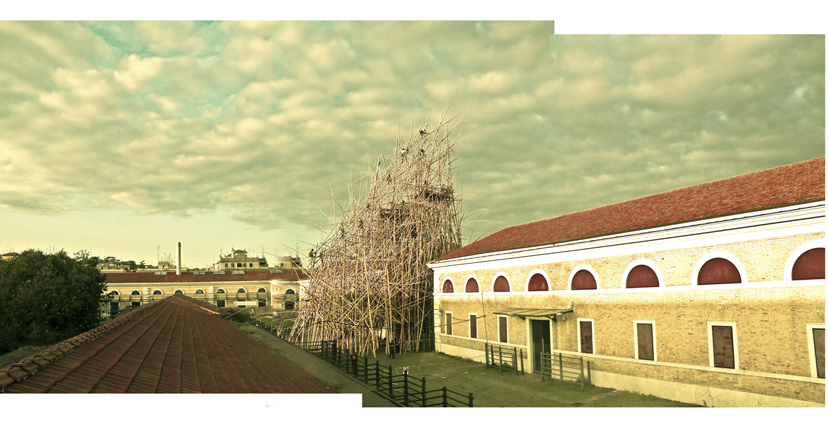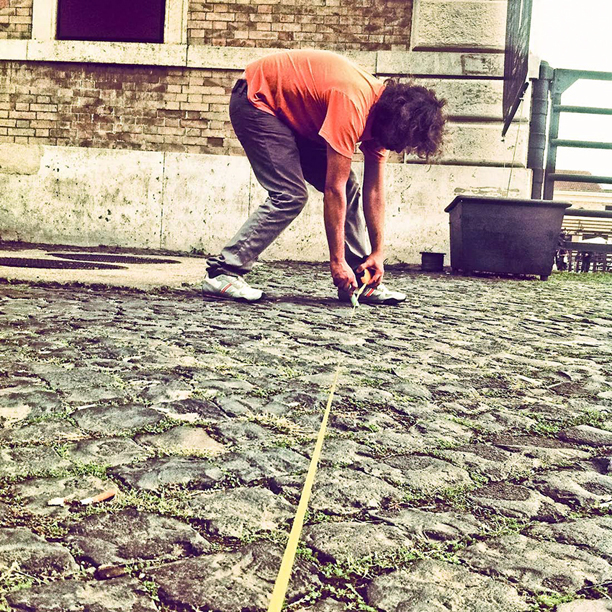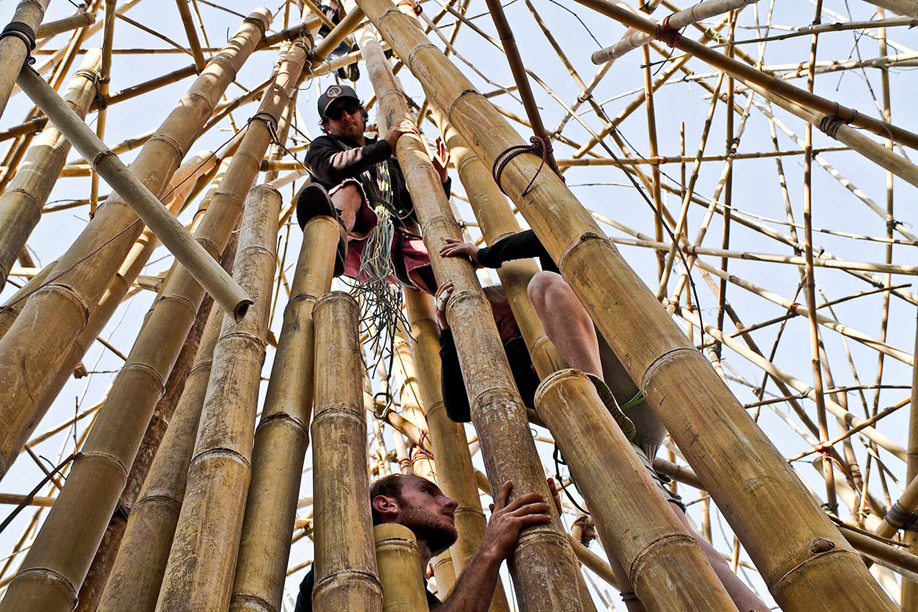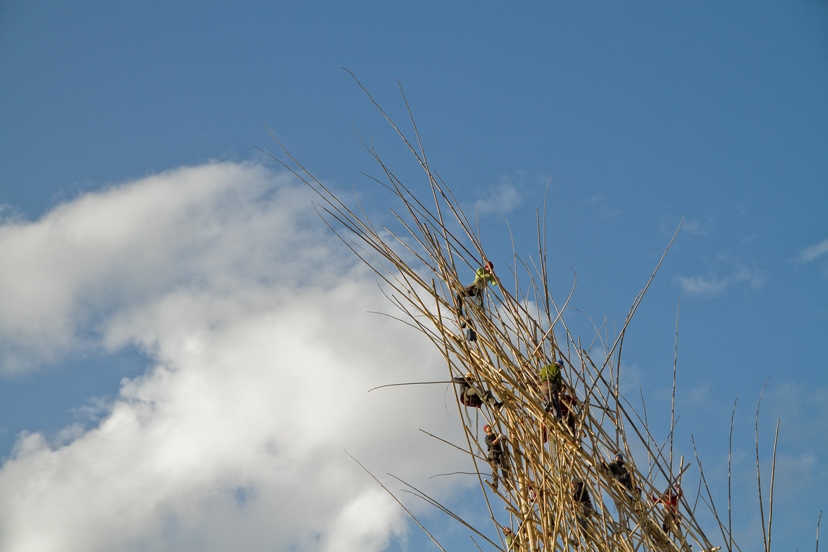Doug + Mike Starn: Big Bambú, Minotaur Horn Head
|
|||||||||
Under the artistic direction of Francesco Bonami, the international award Enel Contemporanea,
ARTIST STATEMET Minotaur Horn Head The concept of Big Bambú has nothing to do with bamboo; it is the invisible architecture of life and living things. Every person, every culture has been built with this architecture, that architecture is chaos, random interdependence of moments, actions becoming interactions, trajectories intersecting - creating growth or change. Big Bambu is the medium of life- we all maneuver our own trajectories in life through the trajectories of every other individual. We gain footholds on their activities and circumstances and use them to move through life- swimming on the chaos medium of life, chaos is a law of the universe, and we recognize it as part of life that we all flow through every day, but more than flow through, we all use chaos- all the time. Everything depends upon one another and the loads are distributed throughout, the interdependence is natural and fluid. There is not too much weight applied to any one thing. The organic growth carries the flow of the load downward and is the energy rising upward. The climbers that build it with us are part of the art - they are the agents that help it rise and reach. In the body of the organism of BB you see all the individual voices of the crew of rock climbers making countless decisions and tying countless knots in brightly colored cord -this is where the interconnections happen and the interdependence of the thousands of randomly directed poles is felt, this is what creates the great unplanned structure, the dangling cords are the evidence. The construction may at first glance look haphazard, but don’t confuse Chaos with Chance, every pole placement and every knot tied is a string of decisions- made by several climbers, over successive time- maybe over weeks or months...and long after we are all gone- the evidence of every decision envelops the visitor. Big Bambú is simplicity and complexity in the same breath. It resonates with life, it is alive, it’s even conscious. Each Big Bambú sculpture is part of the same living organism, continually reconstructed from its own materials, persistently moving forward. This idea, for us, is about cultures, societies, relationships, me, you, and the world itself; all these are made of countless individual elements (or experiences)- all in some way interconnected to the others. Each of these has an innate active virtue and simply through their existence and progressive time they effect a change and eventually what these elements are component of is completely different from what it once was, yet still completely and undeniably the same thing. This growth is happening all the time. In Motorcycle Diaries, Guevara wrote “…me, is no longer me, at least I’m not the me I was.” …or will be. – its never finished and its always complete. In Italo Calvino’s story Baron in the Trees, set in the 18th Century, in which a young nobleman, ‘in revolt against everything and everyone’, turns his back on convention and climbs into the trees, and lives his life in interconnected forests, high above the banality of society and its restrictions.
From up in Big Bambú we can see you on the ground - looking at us up in the sky, making our own world. Working but playing, seeing how high we can get, there aren’t any rules. We are fascinated by connections and rhizomatic fluency. Trees' natural hierarchy is collapsed when they are silhouetted, creating rhizome-like connections everywhere. That’s what thought and creativity are - dark matter- invisible and binding everything together. The no mind not thinks no thoughts about no things. To reach the outlooks you climb a double helix stairway, directions get confused and you are not where you thought you’d be, in this implied labyrinth you don’t kill the beast- you accept it as you, a minotaur. Cities - in their grids and vertical buildings- are controlled environments and seemingly ‘artificial’-they are normally seen as an antithesis of nature and chaos, but what inhabits them?, what is the life of it? -Human animals- people and their goals and their projections - these all exist in chaotic interdependence with each other in progressive time, just as all things in the ‘natural world’. We are the animals that we are, animals that mold the world around us. Big Bambú doesn't play by any rules, you work it out as you go. It’s free and instinctual and it flows.BB is an artwork that creates a 'wildness', freedom and adventure; a wilderness, a mountain. I am connected to everything. I am everything. I am everything that ever happened and everything that ever will happen. So are you. I always was and you always will be. It’s written on every pole and every knot
CURATOR’S NOTES The bamboo “Architecture-Sculptures” by Mike and Doug Starn are able to transform locations radically. The apparent lightness of these structures brings an idea of spiritual, not geographical, nomadism to mind. Their construction is a process of coordination rather than organization, just as the construction of the ships in the Republic of Venice during the sixteenth century: the tension of the work comes to life from this interlocking of seemingly antique building methods and the clearly evident contemporary result. These sculptures, albeit of enormous dimensions, are in no danger of expressing neither monumentality nor self-celebration. The series in bamboo is in reality an “anti-monument” that lauds the creative process and conviviality. Through this work, the Starn brothers have shown that it is possible to create one of the very few pieces of contemporary art that despite being presented as a sculpture embraces organics and life and demonstrates the ability to draw in the spectator and englobe the viewer as an integrating part of the process. Also the choice of materials, simple yet extremely strong, in itself conveys a powerful message and symbolism that evokes concepts of optimism and flexibility - flexibility that not only refers to the physical properties of the material but also to those relating to the mental and conceptual. It may be said that the bamboo project is a representation in space of the human activity known as imagination. The Starn piece is much more complex than a simple tower. The work doesn’t only bond to a vertical architectural development. The structure allows both the vertical and horizontal to cohabit in the spaces. It doesn’t merely rise but also spreads outwards; it moves skywards again to then return to the ground. The unpredictable crisscrossing of the bamboo also serves to reflect the contradictions of human life which is much more similar to an intricate entwinement, however perfectly calculated, than an ascent to the top of the tower. Even in its precision, the project appears as an impromptu process: the visitor must respond to this extemporaneousness by moving unpredictably and spontaneously within the piece itself. There is playfulness in the Starn brothers’ work even though it is neither a toy nor an amusement park. At an amusement park visitors are asked to abandon themselves to the space. This piece requires the visitor to actively participate, as if the work had never been finished; were in constant transformation - as if the sculpture built itself in its own unique way every time a spectator entered. This is a “magical” piece of architecture and sculpture that answers to the individual’s culture rather than a collective one despite being the fruit of a collective effort. It is an effort that with every step opens the doors to new personal experiences that at times can even be intimate. Even in its details, like the ropes that bind the joints and the intercrossing bamboo, all show the individual gesture that is manual and not mechanic. It is not a piece that can be banally termed ecological. It is biological. From its conception to its realization to ultimately its fruition, this piece has always been alive. It is an organism that transforms, moves and adapts itself to natural time as if it were human time. It is an organism that grows not in dimensions but in sensations.
|
|||||||||
PRESS
> For additional information on Big Bambú electronic please email: stephanie@starnstudio.com
![]()














